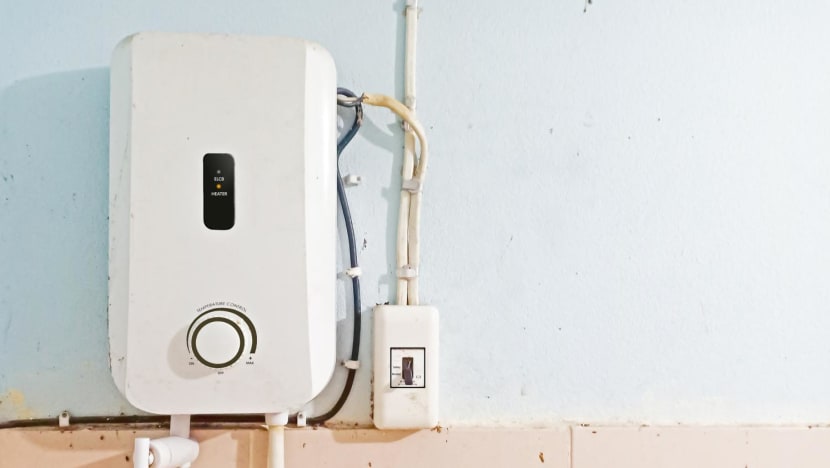Electrocution deaths of Jurong family: Coroner rules misadventure, cautions water heaters should be installed properly

File photo of a water heater. (Photo: iStock)
SINGAPORE: State Coroner Adam Nakhoda on Friday (Jun 3) ruled that the deaths of three people from electrocution in a Jurong flat were a misadventure, and cautioned homeowners to install water heaters and other appliances properly.
Mr Omar Manan, 80, his wife Mdm Asmah Bujang, 66, and their son Mr Muhamad Ashikin Omar, 45, were electrocuted after the cables in a plug supplying power to an instant water heater in the flat fused together. They were pronounced dead on Dec 10, 2020.
Calling their deaths a "truly tragic accident", Judge Nakhoda said the manner in which the water heater was connected to its power source was "wholly inappropriate".
The heater was powered by a three-pin plug connected to an extension outlet, which was in turn connected to a power outlet in the kitchen. The three-pin plug contained a 13-amp fuse.
Investigations by a senior associate engineer with the Energy Market Authority (EMA) found that when the heater was at its highest power setting, it could draw a current of up to 14.2 amps.
The EMA investigator concluded that the main cause of electrocution was the use of the 13-amp fuse plug to supply electricity to the water heater.
Judge Nakhoda agreed with this conclusion. He said that the fuse was damaged through overloading, as the maximum current the heater could draw was more than what the fuse could accommodate.
This overloading, together with intermittent use of the water heater, resulted in a cycle of the cables in the plug heating up and cooling down until the insulation around them melted and the neutral and earth cables fused together.
The fusion was what caused an electrical current to pass through Mr Omar on that fateful day, said Judge Nakhoda, adding that burn marks on the elderly man's hands indicated he was holding the metallic shower head when this happened.
When he collapsed, Mdm Asmah would understandably have entered the bathroom "out of love" to help her husband, who had a history of chronic illnesses including heart diseases, said the judge.
There would have been no indication that there was an electrical fault as the electricity in the flat did not trip, he said.
He said it was likely that she was electrocuted once she stepped on the wet bathroom floor and touched Mr Omar, adding that burn marks on her lower leg corresponded to burn marks on her husband's elbow.
It was likely that Mr Ashikin was subsequently electrocuted when he went into the bathroom to help his parents, after seeing them lying motionless on the bathroom floor, said the judge.
He also said that neither the police nor the EMA were able to identify who had installed the water heater.
NO CIRCUIT BREAKER
The judge also said the incident could have been prevented if the original electrical installation of the flat had been protected by a residual current circuit breaker (RCCB).
An RCCB would trip the system and cut off the current when an earth leakage was detected. The fusion of cables that led to the electrocution was just such an earth leakage, said Judge Nakhoda.
The flat in Block 120, Ho Ching Road was completed in 1971, and Mr Omar and Mdm Asmah had lived in it since the 1970s. It underwent the Housing and Development Board's Main Upgrading Programme, which was completed in 2003.
Its electrical circuitry comprised two wiring systems: The original system and a newer system installed during the HDB upgrading.
The water heater drew electricity from the original wiring system, which was not protected by an RCCB as there was no such requirement at the time the system was installed, the EMA investigator previously testified.
An RCCB was installed for the newer wiring system during the HDB upgrading. This wiring system only powered the flat's utility room.
LESSONS FOR HOMEOWNERS
Judge Nakhoda said that there were lessons to be drawn from this incident.
First, homeowners should ensure that appliances they install are approved for use in Singapore and have the necessary safety certifications.
In this case, the water heater, which was manufactured in 2008 and installed sometime after that, was approved for use in Singapore.
Second, homeowners should ensure that appliances requiring large amounts of electricity are installed according to manufacturers' specifications.
For water heaters, they should be powered through a double pole switch, where cables are positioned in a way that they cannot cross or touch each other.
From the layman's perspective, a double pole switch is the type of standalone switch with a red indicator light often seen outside bathrooms, said the judge.
Under no circumstances should heaters be connected to a power source like a 13-amp fuse plug, he added.
In this case, the manual for the water heater clearly stated that it should be connected to a standalone double pole switch.
Third, if there is no existing double pole switch, homeowners should engage a licensed electrical worker to install such a connection.
Once there is a double pole switch, homeowners should engage a qualified person or technician to install the heater.
Fourth, the entire electrical installation of a house should be protected by an RCCB.
At the end of the hearing, Judge Nakhoda noted that the family of the deceased did not have any concerns to raise regarding their deaths.
He extended his condolences to the next-of-kin, who were in attendance and declined to speak to the media.
















